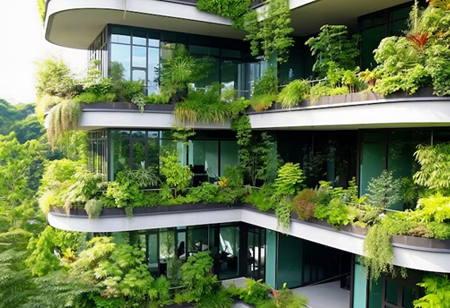
Recently, the urban living has become claustrophobic, sandwiched between the deadlines and demand of corporate life. People of urban area are in need of a moment of fresh air deliberately for their psychological restoration. In spite of having the top-notch amenities at the doorsteps the natural flow of life is embedded in the concrete made skyscrapers and busy roads, and here lies the actual misery of city-life. People are detaching from their roots and environment with each passing day, so, it’s an urgent call for the mankind to think about natural environment. Psychologists believe that the psychological health can be rejuvenated by exposing mankind in the lap of nature.
The idea of introducing & promoting the concept of greenery in the field of architecture is to cherish the opportunity to relief stress, inhale fresh air, and rejuvenate oneself.
Back to those days, Dr. Stephen Kellert was called the “Godfather of Biophilia”, The word “Biophilia” was first uttered by a psychoanalyst named Erich Fromm who quoted that biophilia is the “passionate love of life and of all that is alive…whether in a person, a plant, an idea, or a social group” in his book The Anatomy of Human Destructiveness in 1973. Till date the word Biophilia has been used in many different forms and ways by many scientists, and philosophers. Though the term was coined very recently but the idea of incorporating nature in the construction of building was introduced dates back in the design of the hanging Garden of Babylon which is one of the 7 wonders of the world.
Trees and plants have their own space and characteristics, so, it is not the cakewalk as it sounds like. After many failed efforts ultimately, the architects have found the right way to make advantages of the plant kingdom in the urban style of living. By the end of 2022 the idea of biophilic designs stepped into the urban concrete wall so well that it has become the Holy Grail, as it is rejuvenating our souls. It got immensely popular in the market that all homebuyers are opting for Biophilic buildings. Biophilic structure offers the dwellers ample amount of daylight, airflow, greenery, and water.
Pillars of Biophilic Building
The concept of Biophilic Architecture is based upon its three pillars-
Distinctive Characteristics of Biophilic Architecture
Environmental Aspect: The use of plants in the architecture fosters the connection between man and nature which naturally releases stress giving him a gateway of relieving the fatigue by rejuvenating from inside. Such buildings should have a minimal use of bright colors, green facades, garden area having a whole range biodiverse nature, open fountains and waterbodies. These elements promote a healthy habitat and ecosystem, having interconnection between the various elements of ecosystem.
Natural Shapes & Forms: Such buildings always use natural shapes and forms and avoid using straight lines and right angles. The shapes which promote natural rhythm or imitate natural shapes are spiral, arch, tree shaped, dome shaped, oval, tubular forms, few motifs of natural elements. The shapes of bee Hive are recently trending in both architecture and interior design for its aesthetic and chic style of art.
Broader Space & Daylight: It is very important to create a broader open area which allows the broad daylight to reflect and shine all over the place. Such buildings need more space than the usual buildings for their use of plants and sculptural designs.
Place Based Relationship: A particular place has its own story, climate, ecology and flavor. It is the connection between the soil of some place and the territorial plants which come into play with the mankind. Now-a-days boutique resorts are very trending which uses this idea of having particular design thinking of the local elements. People mostly prefer such concept because it allows them to feel the nature being close to it.
Human Nature Relationship: This is the key feature of Biophilic design. The main motto of this design is to form a bosom friendship between Man and Nature. It is very eye-soothing to see the lush greenery or the garden having the daisies tossing their heads with the breeze and bees and butterflies are buzzing around.
Economic Benefits of Biophilic Design
Biophilic designs are very popular in interior design too. The customers are opting for eco-friendly design which enhances the beauty with creating a scope for the connection with nature. Wall art using small plants, indoor plants kept in chic designed ceramic pots are the new style statement of any urban apartment.
The Real Estate and Architecture industry recorded about Rs.1.72 billion dollars in 2019 and it is estimated to grow by about Rs.65,000 crores by the year 2040. Architects and Interior Designers are brooding over new ideas and designs to extract huge sales. Though many Asian and European countries like China, Norway Japan have successfully infused the whole idea and fetching benefits of it but this new fangled design needs a lot more research for the finesse. So, all in all Biophilic designs are costly to add in construction but it is enduring for the better future.
Copyright © 2024 HomesIndiaMagazine. All Rights Reserved.